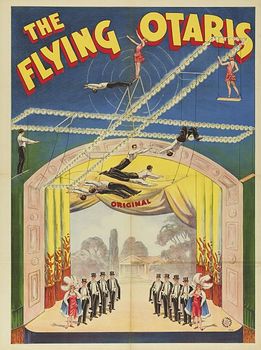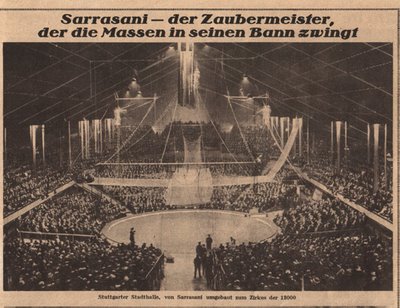
The novelty fever that always invaded circus and variety world affected acrobats in the strangest and most seductive ways.
Falling the curtain on the Codona legend, the art of flying trapeze in the mid-30’s is not remembered for remarkable stars, if we except the Concellos.
I’ve assembled some pictures of the german Otaris: I think that they likely are the originators of the “cross” trapeze act.
Yes, two trapeze bridges was presentes simultaneously.

The Otaris was 10, of which two women.
But what was most impressive, is the elegance and modernity of their act.
We can deduce that they was wearing white silk tails and evening dresses, and their “bridge” was graced by hundreds of bulblights.
You can see this in th artist’s poster, a Friedlander litograph dating 1929.
In the following years, no wonder that they was starring for the most elegant circus of its times, Sarrasani: the two balck and white photographs shown here (above and down) are from a Sarrasani program of 1930.
Otaris were a star act, even if Sarrasani never promoted them of a personalized publicity. He in fact used to say: “I don’t book stars: Sarrasani is the star…”
In 1929 Sarrasani was the first circus ever in continental Europe to produce a winter show in a large hall, seating 12.000 (he was the first in many things).
 In the panoramic view of the hall, you can see the Otaris on their “bridges” and their cross-net.
In the panoramic view of the hall, you can see the Otaris on their “bridges” and their cross-net.
Then, in 1935, the Otaris left Europe crossing the Ocean...

No comments:
Post a Comment